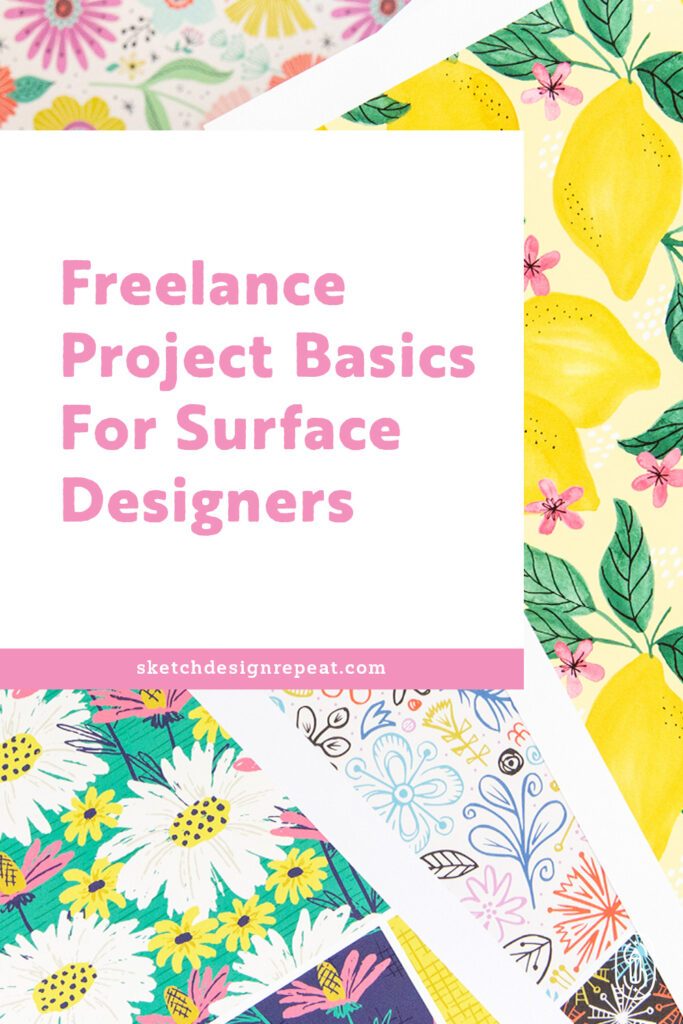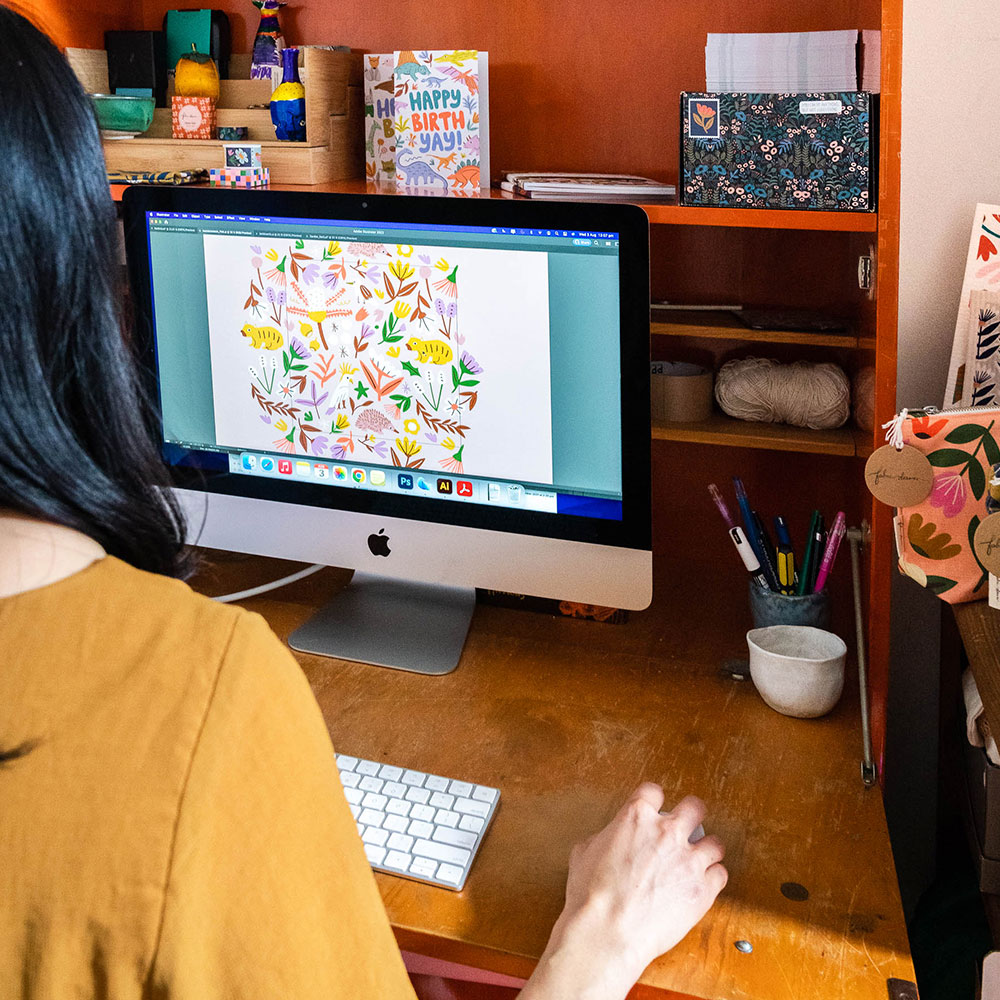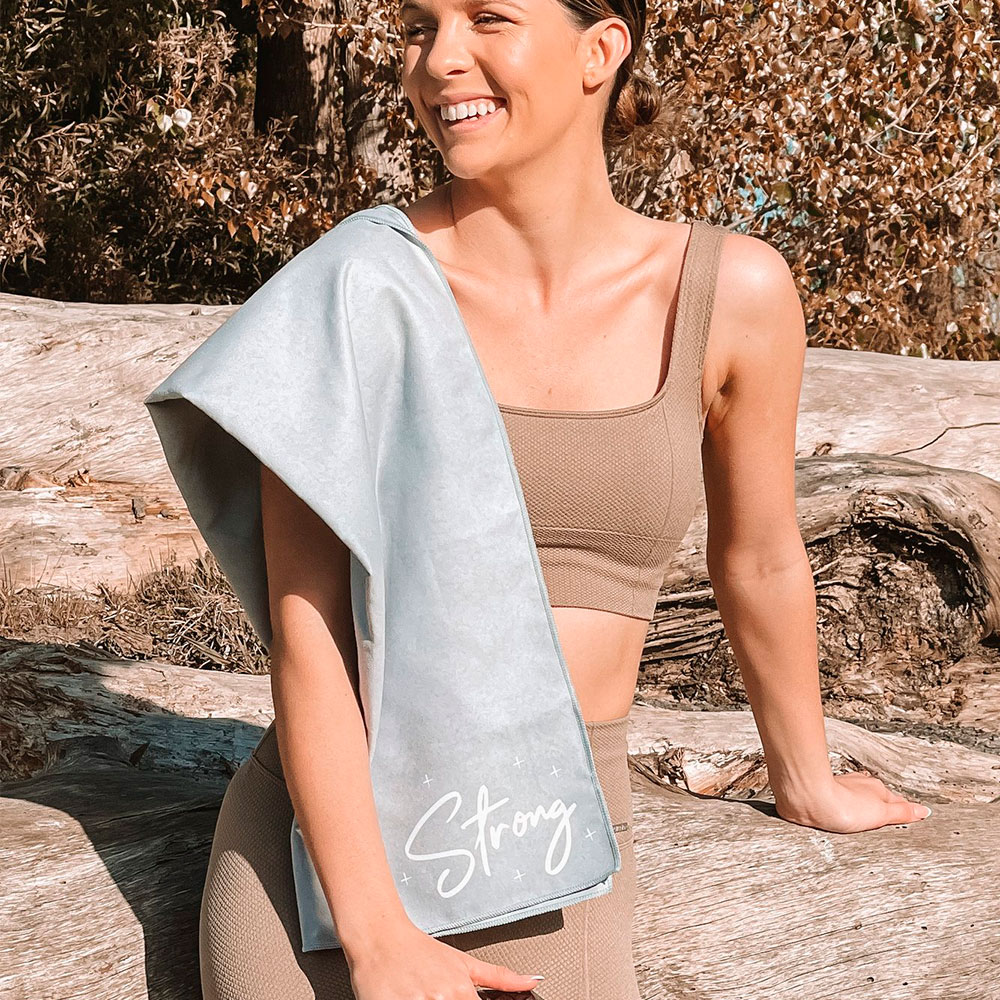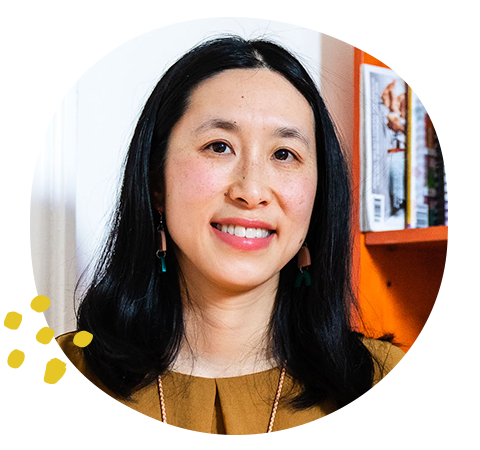When I started in surface design and creating pattern repeats, my first assumption was that art licensing was the only way to earn money from my work. I quickly realized that licensing is just one of the many ways you can earn money as a surface designer, and that it was also possible to find surface design freelance projects.

After working as a graphic designer for many years, I had always associated freelance design work with logos, brochures, or similar graphic design work that I was keen to move on from. It took a number of years before any freelance work came my way, because I needed to find my ‘style’ and figure out what kind of surface design freelance work I could and wanted to do.
Although I found my way into surface design through a love of repeat patterns, over the years I’ve worked on a mixture of illustrative, hand lettered, and patterned projects such as event signage, book illustrations, photo cards, door mats and gym towels. I’ve been able to stretch myself creatively and become more versatile to take on different projects, while continuing to pitch my own pattern repeats to license.
How is freelance work different from art licensing?
Freelance work will often involve the client having a specific brief for you to create new art. The briefs can be for art that may be outside of your usual style or themes. Depending on the arrangement or contract in place, you may not be able to use the artwork elsewhere as it has been specifically created for the client.
Licensing usually involves selling or ‘loaning’ art that you have already created. I have a portfolio of work that I send to potential clients and from there, the client may select something they would like to license for their product/s. There may be some additional work, such as color change requests or setting up the file for print, but once a design has been selected, it’s fairly quick to finalize on my end.

How do you find freelance work?
It can be difficult to know where to find freelance clients. Often the best way to start is with people you know or in your local area. Is there a friend needing a cute illustration for packaging labels for their side hustle or a local gift shop wanting a custom pattern for wrapping paper?
Clients you are pitching your art for licensing might actually also want a designer to create some custom work. I’ve also had clients approach me, so it’s important to continue sharing your work on social media and having a website with examples of your work, so clients can easily see if you’re the right fit for their next project.

What’s the process of working on a freelance job?
It’s exciting when you’re asked to work on a freelance project and also nerve-racking because you want to make sure you do a good job.
1) The brief
The first thing in any freelance project is to get a brief of what the client is looking for. Some clients may be very clear on what they are after, have a written brief or even mood boards, while other clients may not have anything beyond a brief email. It’s important to take the time to find out what they are after, so you have a better idea of how long it will take and how much it will cost.
2) The initial (video) call
I always find having an introductory video call helpful in the early stages, even though it can be a little daunting. Not only can you ask questions and get answers straight away without going back and forth on email, it also helps put a face to the name, and build trust and connection with the client. If the project goes well, you want to be able to work together again.
3) Your quote
Before you start doing any work, you’ll be asked to provide a quote of how much the project will cost. Don’t be afraid to ask questions to be clear on what the client is after before you put this together.
You may quote an hourly rate or a project cost. This depends on what works best for the client and yourself.
Hourly Rate
I find an hourly rate works for projects that may have ongoing work or changes. You may just need to quote your hourly rate and then provide the total hours with your invoice. Charging by the hour ensures you get paid for the hours you work, which should also include your overheads. What you charge per hour should reflect your experience and you can increase this rate as you gain more experience.
Project Cost
You may also quote on the whole project. I find this happens for one-off projects, like a book illustration or a set number of designs where the client wants to know if the whole project fits within their budget. I usually work out how long I think the project will take and multiply that by my minimum hourly rate to get a starting figure.
I always add an additional amount to factor in a project taking longer than I anticipate (it almost always does!) or additional changes the client may make, but I always make it clear on my quote that only a certain number of changes are allowed before an hourly rate is charged to prevent a client thinking they can make unlimited changes.
There may be other costs you may want to factor in, for example, if the client owns the rights to the artwork after completion, or if the turnaround is tight and you need to work evenings or weekends to finish it. Artful Pricing covers freelance project fees in depth btw.
Related Article: 3 Tips to Negotiate Higher Freelance Rates
If there’s no contract from the client, make sure your quote lists exactly what work is covered and what files are provided on completion. Don’t start any work until the client has approved the quote. Generally, I invoice the client after the work has been completed, but you can always ask for an amount in stages for large and longer projects.

What are the pros and cons of freelance projects?
PRO: You get paid for your work
Whether you charge hourly or per project, you know you’ll get paid for your time and effort regardless of whether the client uses the design/s. I can’t tell you how many hours I’ve spent creating patterns to only have them sit in my portfolio unused.
PRO: There’s an opportunity for repeat work
Some freelance projects are one-offs, but others can be ongoing, potentially giving you regular work that licensing doesn’t always offer.
PRO: You get to work on different kinds of briefs
There’s an opportunity to work on projects that can stretch you creatively. Often the briefs you’ll be given are outside of the themes and even style you usually work. These projects can be added to your portfolio, which can help you gain more freelance clients.
Related Article: Finding Freelance Design Jobs
with Smaller Companies
CON: You’re unlikely to be credited for your work
The majority of the freelance projects I have worked on have not credited my name as the designer behind the work. This is very different from art licensing where I would request an artist credit and be promoted as the artist in any marketing.
CON: You don’t always work in your style
While this can be seen as a positive, you may have freelance projects that are so far from your usual style that it can be quite challenging (and sometimes frustrating) to work on.
CON: Timelines can be tight
You might be expected to complete a job within a short turnaround time, so often you can feel under pressure to complete a job to a high standard (which can be hard when you’re trying to get into a creative flow!). Often this can mean putting other things aside and putting in extra hours in order to complete the job.
So whether you’re just starting out in surface design or are a seasoned designer, anytime is a good time to start looking for freelance opportunities and grow your surface design career beyond art licensing.

Written by Beck Ng
Website: www.fabricdrawer.com.au
Instagram: @fabric_drawer
Beck is a surface designer and maker living in Melbourne, Australia, who has a love of creating patterns. She started her creative business Fabric Drawer showcasing her work on a range of products, as well as collaborating with a range of local and international companies.
Dear Beck, thank you for this helpful overview. I especially like the tip of setting up an initial video call to clarify the brief – while at the same time building trust and connection with the (potential) client 🙂
Cheers, Reine